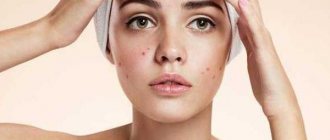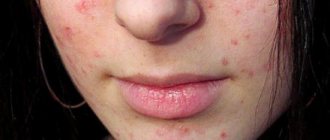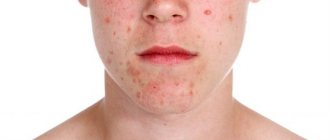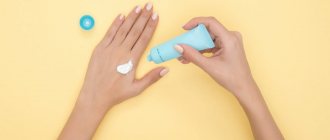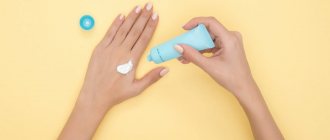Uneven skin texture is one of the unpleasant cosmetic problems that causes discomfort and irritation to its owner. Uneven facial skin texture is quite difficult to disguise. The use of cosmetics, most often, does not bring the desired result.
Most oil-based products can cause skin irritation, especially if your skin is oily. It is also inadvisable to use alcohol-based products, which can cause minor burns and damage to the delicate skin of the face. Applying makeup makes the uneven surface even more noticeable, giving it an unsightly appearance.
An excellent alternative to home treatment and care for problem skin is ultrasonic cleaning. This is an effective, painless and safe procedure, thanks to which the skin on the face can acquire a smooth and beautiful appearance.
Causes of uneven facial skin texture
Numerous observations and studies by specialists indicate that the main reasons for the uneven surface of the skin of the face are:
- adolescence;
- acne and acne scars;
- enlarged pores;
- improper skin care;
- use of low-quality cosmetic products.
The skin is the largest organ in the body. It acts not only as a cover, but also as our protection. Many people may have an uneven skin surface due to their tendency to develop pimples and blackheads, which often results in scars of varying sizes that are a physical disability. This usually occurs during puberty when the sebaceous gland is very active and therefore produces too much oil.
Many people also face the problem of deep pores on the skin, which subsequently threatens to change the skin texture. Enlarged pores have an unsightly appearance and cause a number of inconveniences and discomfort. Contributing factors to this condition may be:
- heredity;
- clogged pores;
- age;
- lack of water;
- smoking;
- sun damage.
There is no permanent solution for reducing pore size. However, a proper understanding of why pores become noticeable when they are enlarged, infected or clogged with oil and with the right skin care regimen can reduce the appearance of enlarged pores.
Procedures using ultrasound, which today has taken a leading place in cosmetology, will help get rid of the above problem. Self-medication can only aggravate the situation and not bring the desired result.
Practice confirms that uneven facial skin texture is also the result of an excess of dead cells accumulating on the surface of the skin. Because of this, the surface becomes rough or uneven to the touch, and also looks quite dull. The factors that lead to this condition are the following:
- skin aging;
- chronic sun exposure;
- smoking;
- skin diseases (for example, eczema).
Basic principles of skin smoothing treatments
- safety, non-traumatic;
- solving individual patient problems (selection of means and methods, as well as their optimal combination);
- work of the patient in a team with a cosmetologist (following recommendations and informing the doctor about lifestyle);
- eliminating symptoms and eliminating the root causes of the disease;
- cleansing the skin without over-drying, since a violation of the water balance leads to a worsening of the acne situation;
- removal of keratinized cells followed by restoration of the integument;
- maximum protection from factors affecting treatment: sun, poor environment, dust, etc.;
- systematic (cyclical): you need to visit a cosmetologist regularly.
The effectiveness of ultrasound in the fight against uneven facial skin textures
Ultrasonic facial cleansing is one of the important steps in cosmetology; thanks to its action, uneven skin surfaces caused by acne in the past are reduced. An uneven surface of the skin is most often formed due to damaged cells and skin particles that are located between the layers of the skin. It's a fact that oily skin tends to produce five times more dead cells than normal skin, making it more prone to blemishes. For oily skin, it is essential to keep it sufficiently hydrated to ensure that sebum production is reduced. The skin's natural reaction to protect a dehydrated surface is to increase the amount of the above substance.
Ultrasonic cleansing causes the skin to speed up the skin cell renewal process to replace damaged skin on the surface layer. The causes and treatment of uneven facial skin texture are determined and prescribed by a qualified dermatologist. New ultrasound treatment methods help many people maintain youth and beauty.
The initial stage in smoothing the skin relief with ultrasound is diagnosis. Determining the cause of the existing skin condition will allow all measures to be carried out comprehensively, competently and effectively.
In order to learn how to remove uneven facial skin texture, clinic patients are told about the effectiveness of modern ultrasound devices used for therapeutic purposes to even out facial skin texture, confirming their safety and effectiveness with practical results. Feedback from patients who were helped to improve skin texture with ultrasound testify to the quality and effectiveness of such an event.
How to remove jowls at home
Expert comment:
“There are cases when it is not at all necessary to resort to the services of doctors to get rid of jowls. Often, overweight young people simply need to lose weight. Excess fat on the face will disappear, elastic skin will tighten, and the facial contour will become smooth and graceful.
The main thing is to avoid rapid weight loss, otherwise the skin will sag before it has time to shrink. It is best to lose weight by 4-5 kg per month under the supervision of an endocrinologist in combination with physical activity. Fat “burns” only in the muscles, and to get rid of fat in the cheeks you need to tense all the large muscles of the body.”
Maxim Vasiliev, plastic surgeon.
Types of laser peeling for the face for wrinkles and other skin problems
- Cold laser peeling
This is what is commonly called superficial laser peeling, which does not heat the deep layers of the epidermis and does not affect the dermis. It evens out skin texture and tone well. After a course of superficial peeling, she looks smooth and radiant - the effect of the procedure is similar to acid peeling, which visually rejuvenates the face.
Before the procedure, local anesthesia is required (a special anesthetic cream is applied to the skin). Complete exfoliation occurs in 2–3 days. There is no severe swelling.
- Hot laser peeling
The technique involves influencing at a deeper level, which also affects the effect - it is more pronounced and comparable to medium acid peeling.
Deep laser peeling can be carried out with different types of devices - fractional and standard. The second type is more traumatic; in this case, the laser beam damages the entire skin, making several passes and evaporating the epidermis layer by layer. The dermal layer also warms up, which helps stimulate the production of protein structures.
A deeper effect on the skin makes the painful sensations stronger. Rehabilitation is not quick or easy. Swelling persists for several days, the face is covered with crusts that disappear for at least a week. But after healing, the rejuvenating effect is impressive: the skin texture is evened out, it is noticeably tightened, it becomes more elastic and firm.
- Fractional laser peeling
This procedure is much easier to tolerate than the previous one, and recovery after it is easier, because during laser exposure the skin is not completely damaged. Between the areas heated by the laser, there are microscopic zones that are not affected by the laser. Fractional laser peeling can be either cold or hot - the method allows for exposure at different levels.
You can also find another name for this peeling – laser photothermolysis. The advantage of a fractional laser compared to a traditional one is its targeted effect. During photothermolysis, the laser beam breaks up into a mass of very thin beams. The impact on the skin occurs from the superficial to deep layers. Nevertheless, the tissues are damaged fragmentarily and in doses, and there are untouched gaps between the injured areas, so rehabilitation does not take much time and causes virtually no discomfort. The procedure itself does not cause pain either.
It takes about five days for the microscopic crusts to disappear. You can see the result within a week. And although many are satisfied with the effect after the first procedure, it is recommended to complete a course (3-4 sessions) so that the skin is completely renewed.
Recommended articles on the topic:
- Ultrasonic facial peeling is a pleasant and beneficial procedure for your skin
- Redermalization of the skin: all the pros and cons
- Almond peeling for the face: features of the procedure
- Carbon laser peeling
Laser carbon peeling is a new procedure, it is aimed at deep cleansing the skin, is effective and painless. In another way, this peeling is called carbon cleaning. It is used if the skin is acne-prone or too oily. At the first stage, a mask with carbon dioxide (CO2) is applied to the face; laser peeling is done directly at the second stage, when the mask has dried.
Principles of treatment, methods of hardware treatment
Treatment of uneven skin color should begin with identifying the cause of this condition - otherwise, even after solving the problem, you risk relapse and/or worsening of the condition after some time. If a change in tone is caused, for example, by a disease or taking medications, it is necessary to treat the patient and/or discontinue/adjust the prescribed drug. Most likely, this will require interaction between a cosmetologist and dermatologist with doctors of other specialties.
UV filters to exposed areas of your body daily and stop visiting the solarium. To protect against blue light (HEV rays), you should limit the time you use gadgets (monitors, laptops, tablets, smartphones), working with them only when necessary. It is also not recommended to use them several hours before bedtime, and especially not in bed.
Residents of large cities are recommended to use cosmetics with the so-called “pollution protection factor” (PPF). Such cosmetics may contain the following protective complexes: Pollushield, IBR-Pristinizer, 28Extremoin, EXO-P, SymUrban, etc. For example, one of the recent developments includes acids obtained from hibiscus (Hibiscus acids), which due to chelating ( metal-binding) action prevents the appearance of age spots on the skin.
Epidermal Growth Factor (EGF) helps even out complexion - it stimulates cell growth and division, renewing the epidermis. When using products with EGF, there is a gradual increase in the synthesis of DNA, RNA, hyaluronic acid, collagen and elastin - as a result, the appearance of the skin quickly improves. Epidermal growth factor is also called Beauty Factor.
Arbutin evens out the tone well and brightens the skin. In addition, it has an antioxidant effect, improves the protective properties of the skin and promotes its recovery after sunburn. However, the concentration required to achieve a lightening effect and the duration of use of arbutin have not yet been identified. Apparently, the individual sensitivity of the skin, the depth of the pigment and other factors are of great importance.
To correct uneven tone, you can use peeling agents with acids . They reduce the pH in the stratum corneum of the epidermis and at the same time bind calcium ions. Calcium ensures the “gluing” of epidermal proteins, and when it is removed, intercellular connections weaken - keratinocytes begin to peel off, which serves as a signal to activate the division of young cells. As a result, the skin brightens and its tone evens out.
If uneven skin color is associated with uneven distribution of melanin in the epidermis, this problem can be effectively solved using hardware cosmetology methods . There are two approaches used here:
- The first approach is the selective destruction of melanin using heating with visible and near-infrared light, for example, IPL therapy, implemented in the M22-IPL device.
- The second approach is the destruction of the epidermis in order to trigger its renewal. This approach was previously often implemented using laser resurfacing, a method that involves complete vaporization of the epidermis in the treated area. Today, fractional lasers are used to “replace” the epidermis: non-ablative, such as Fraxel, Clear+Brilliant M22-ResurFX, and ablative, such as Acupulse and Ultrapulse.
The effectiveness of fractional lasers in evening out skin color depends on the percentage of the epidermis destroyed, however, these lasers, if used incorrectly, can cause complications in the form of hyperpigmentation. Therefore, when using them, you need to be careful in choosing the impact parameters and procedure techniques.
Questions from our users:
- uneven complexion
- uneven complexion how to deal with it
- uneven skin color in the bikini area
- uneven skin color causes
Is it possible to fight jowls using conservative methods?
Unfortunately, all home methods are preventative. Removing jowls without surgery is only possible if they have just begun to appear and have not yet gained a foothold in their occupied “positions.”
You can start eliminating jowls with lifting masks.
One of the most effective modeling masks is a tar mask: finely grate 1/8 of a piece of tar soap and beat into foam, adding a little sour cream. Apply the resulting mixture to the chin, neck and décolleté. Let it dry and reapply the mask until completely dry. Then rinse with warm water and lubricate the skin with cream. This mask has a strong lifting effect and will significantly tighten slightly sagging skin in just a month.
You can use ready-made pharmaceutical masks. Look for marine plankton, kelp, brown algae, lecithin, panthenol, and allantoin in their composition.
You can also do a facial massage yourself: twist a small terry towel into a rope, soak it in a saline solution and pat your lower jaw and neck on all sides for 15 minutes. After the procedure, lubricate the skin with cream.
Leather and its features
Human skin is a multifunctional organ, the condition of which is in close relationship with other organs and systems of the body. It has 3 layers, the thickness of which differs in different parts of the body. This:
- epidermis;
- dermis;
- subcutaneous fat tissue.
The epidermis is the top and thinnest layer of the skin. Moreover, it itself has a multilayer structure and is formed:
- stratum corneum;
- glassy or shiny layer (present only in the skin of the palms and soles);
- granular layer;
- spinous layer;
- basal layer.
The epidermis is 85% composed of keratinocytes - cells that contain keratin and successively undergo stages of differentiation, shifting from the basal layer to the spinous, granular and gradually losing water, the nucleus and turning into prismatic scales of the stratum corneum. The latter are called corneocytes. At the same time, the epidermis is constantly renewed due to the desquamation of corneocytes of the uppermost stratum corneum and its replacement by other keratinocytes, which also transform over time into corneocytes and are ultimately desquamated.
Thus, the skin is constantly renewed. If this process is disrupted due to the action of certain factors and desquamation slows down with thickening of the granular and stratum corneum of the skin or excessive formation of creatine is observed, hyperkeratosis develops.
Is it possible to get rid of it without surgery?
Today, various cosmetic procedures are actively and widely used to restore a smooth surface of the skin. Even with severely pronounced lumpiness of the skin in the facial area, they try to start treatment with therapeutic methods. As a rule, plastic surgery must be resorted to only in extreme cases and when cosmetic procedures are ineffective.
On the Internet you can find a considerable number of photos confirming the effectiveness of non-surgical techniques.
What is hyperkeratosis
Hyperkeratosis is a pronounced thickening of the stratum corneum of the epidermis, which can reach from several millimeters to several centimeters. Depending on the changes occurring in the skin, thickening of the granular and spinous layers of the epidermis, which is called proliferative hyperkeratosis, or a slowdown in the rate of exfoliation of horn cells may be observed. In the latter case, the thickness of the granular and spinous layers, on the contrary, decreases. This is called retention hyperkeratosis.
Hyperkeratosis is not an independent disorder, but is a symptom of a whole group of skin diseases. It is characterized by excessive keratinization of individual areas or the entire skin. This can be due to a number of reasons, and only sometimes hyperkeratosis can be congenital or hereditary and act as a manifestation of ichthyosis, Mibelli porokeratosis and some other diseases. But if in this case the child has signs of skin disorders practically from birth, then with acquired hyperkeratosis they arise throughout life. They cause not only serious physical discomfort, but also psychological discomfort due to changes in appearance, especially if signs of the disease appear on the skin of visible areas of the body and especially the face.
Hyperkeratosis is also present in healthy people on the elbows, feet, and in rare cases on the knees, i.e., in places of greatest skin friction.
The reasons for the development of acquired hyperkeratosis can be external influences and disturbances in the functioning of the body, and their combinations are often observed. This:
- prolonged pressure on the skin of clothing or shoes;
- prolonged friction with items of clothing, accessories;
- constant contact with lubricating oils, petroleum products, coal and other similar substances;
- disruption of the endocrine system;
- deficiency of vitamins A and C or only one of them due to gastrointestinal pathologies or poor diet.
Hyperkeratosis can also be a manifestation of diseases such as:
- mycosis, i.e. fungal infection of the skin;
- atopic dermatitis;
- psoriasis;
- disseminated and discoid lupus erythematosus;
- seborrheic dermatitis;
- leprosy;
- lichen planus;
- neurodermatitis;
- erythroderma;
- celiac disease (celiac disease);
- eczema;
- xeroderma pigmentosum;
- diabetes mellitus, etc.
With facial hyperkeratosis, the presence of seborrheic dermatitis or discoid lupus erythematosus is often suspected. With the latter, round or oval pink spots with a bluish tint and sharp boundaries appear on the cheekbones, nose, cheeks, sometimes ears, neck and lips, which tend to increase to 5 cm and merge, and then become covered with dry dense scales.
Hyperkeratosis often occurs in older people. In such situations, it is usually caused by age-related changes in the skin and affects the back and extensor surfaces of the limbs, although it is possible that the face can also be affected.

